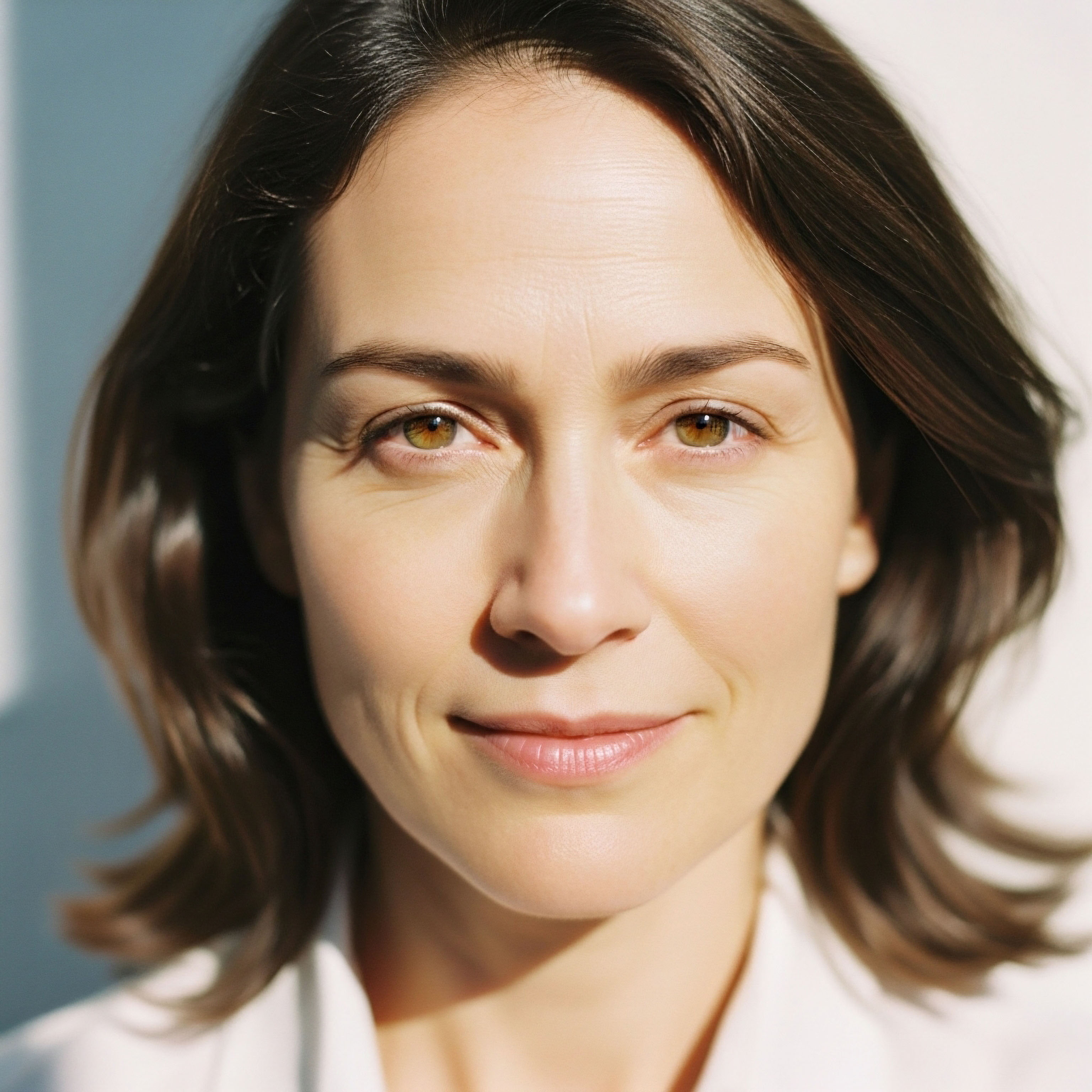

Fundamentals
Have you ever noticed a subtle shift in your vitality, a quiet diminishment of the energy and resilience that once felt so natural? Perhaps your sleep patterns have changed, your recovery from activity feels slower, or your overall sense of well-being has dimmed.
These experiences are not simply an inevitable consequence of passing years; they often signal a deeper conversation occurring within your biological systems, particularly concerning your endogenous hormones. Understanding these internal messengers, and how they respond to your daily actions, holds the key to reclaiming that vibrant function.
Our bodies operate through an intricate network of chemical signals, and hormones serve as the primary communicators within this system. They orchestrate nearly every physiological process, from metabolism and mood to muscle growth and reproductive health. As we age, the production and sensitivity of these vital compounds naturally undergo alterations.
This can lead to a cascade of effects, often manifesting as the very symptoms many individuals attribute solely to getting older. Recognizing these shifts marks the first step toward a more informed and proactive approach to your health.

The Body’s Internal Messaging System
Consider your hormones as a sophisticated internal messaging service, delivering precise instructions to cells and tissues throughout your body. These messages dictate how your body utilizes energy, repairs itself, and maintains balance. For instance, testosterone, often associated with male physiology, plays a significant role in muscle mass, bone density, and cognitive function for both sexes. Similarly, estrogen and progesterone are not only central to female reproductive health but also influence bone health, cardiovascular function, and neural activity.
Another critical player is growth hormone (GH), which supports cellular repair, protein synthesis, and metabolic regulation. Its production naturally declines with age, a phenomenon sometimes termed somatopause. This decline contributes to changes in body composition, including increased adiposity and reduced lean muscle mass. The interconnectedness of these hormonal pathways means that a change in one area can ripple across the entire system, influencing your overall health trajectory.
Your body’s hormones act as vital internal communicators, orchestrating physiological processes and influencing your well-being as you age.

Exercise as a Biological Stimulus
Exercise represents a powerful, non-pharmacological stimulus capable of influencing these hormonal dynamics. It is not merely about burning calories or building visible muscle; it is a profound biological signal that can recalibrate your endocrine system. Different forms of physical activity send distinct messages to your hormonal glands, prompting varied responses in hormone synthesis, release, and receptor sensitivity. This capacity to modulate internal chemistry through movement offers a compelling avenue for supporting health as the years progress.
When you engage in physical activity, your body perceives a demand for energy and adaptation. This perception triggers a series of physiological adjustments, including the release of various hormones. For example, a challenging session of resistance training signals the need for muscle repair and growth, prompting the release of anabolic hormones.
Conversely, sustained aerobic activity influences metabolic hormones and stress mediators. Understanding these specific interactions allows for a more targeted application of exercise, moving beyond general recommendations to a truly personalized wellness protocol.

The Endocrine System’s Adaptability
The endocrine system, while subject to age-related changes, retains a remarkable degree of adaptability. This means that even as endogenous hormone production may decline, strategic interventions can help optimize the remaining capacity and improve cellular responsiveness. Exercise, when applied thoughtfully, serves as a primary tool in this optimization process. It can enhance the efficiency of hormonal signaling pathways, improve the sensitivity of target tissues to existing hormones, and even stimulate the production of certain beneficial compounds.
This adaptability underscores a fundamental principle of biological systems ∞ they respond to appropriate challenges. When faced with the demands of structured exercise, the body initiates adaptive processes that extend to the hormonal realm. This includes improvements in insulin sensitivity, a critical factor in metabolic health, and modulation of cortisol, the primary stress hormone. By consciously selecting specific exercise modalities, individuals can actively participate in shaping their hormonal landscape, supporting vitality and function throughout their lifespan.


Intermediate
Moving beyond the foundational understanding of hormones and exercise, we now consider the specific clinical implications of various exercise modalities on endogenous hormone production in aging individuals. The precise ‘how’ and ‘why’ behind these interactions reveal a sophisticated interplay between muscular activity, metabolic demand, and endocrine signaling. Tailoring exercise prescriptions based on these insights can significantly influence hormonal balance, potentially complementing or reducing the need for external hormonal optimization protocols.

Resistance Training and Anabolic Hormones
Resistance training, characterized by activities that challenge muscles against an external load, stands as a potent stimulus for anabolic hormone production. This includes hormones like testosterone, growth hormone (GH), and insulin-like growth factor 1 (IGF-1). When muscle fibers experience mechanical tension and metabolic stress from lifting weights, a cascade of signaling events begins. This signaling prompts the pituitary gland to release more GH and the testes (in men) or adrenal glands/ovaries (in women) to produce testosterone.
The intensity and volume of resistance training significantly influence these hormonal responses. Protocols involving moderate to high intensity (70-85% of one-repetition maximum) with multiple sets and shorter rest periods tend to elicit a greater acute hormonal response. For aging individuals, this means prioritizing compound movements that engage large muscle groups, such as squats, deadlifts, and presses. Such movements create a systemic demand that maximizes the hormonal signaling for muscle protein synthesis and tissue repair.
Resistance training, especially with high intensity and volume, stimulates the production of anabolic hormones like testosterone and growth hormone.
For men experiencing symptoms of low testosterone, often termed andropause, consistent, progressive resistance training can help optimize remaining endogenous production and improve androgen receptor sensitivity. While exercise alone may not fully restore levels to youthful peaks, it forms a foundational component of any comprehensive male hormone optimization strategy, often working synergistically with targeted testosterone replacement therapy (TRT) applications.
Similarly, for women, resistance training supports healthy testosterone levels, which are crucial for bone density, lean mass, and libido, particularly during peri- and post-menopausal transitions.

Aerobic Activity and Metabolic Regulation
Aerobic exercise, encompassing activities like brisk walking, jogging, or cycling, primarily influences metabolic hormones and stress mediators. Its consistent practice improves insulin sensitivity, meaning cells become more responsive to insulin’s signal to absorb glucose from the bloodstream. This is particularly relevant in aging, where insulin resistance can become more prevalent, contributing to metabolic dysfunction. Regular aerobic activity helps maintain stable blood glucose levels and reduces the burden on the pancreas.
Regarding stress hormones, moderate aerobic exercise can help regulate cortisol levels. While intense, prolonged aerobic activity can acutely elevate cortisol, consistent moderate-intensity training generally contributes to a more balanced cortisol rhythm over time, supporting overall adrenal health. This is vital because chronically elevated cortisol can negatively impact testosterone production, thyroid function, and immune response.

High-Intensity Interval Training and Hormonal Pulses
High-intensity interval training (HIIT) involves short bursts of maximal effort followed by brief recovery periods. This modality creates a unique hormonal signature, often eliciting a greater acute release of growth hormone and catecholamines (like adrenaline and noradrenaline) compared to steady-state aerobic exercise. The intense, intermittent nature of HIIT mimics the body’s natural pulsatile release of certain hormones, potentially enhancing their signaling.
For aging adults, HIIT can be a time-efficient method to stimulate hormonal responses that support body composition improvements, such as fat loss and muscle preservation. The acute metabolic stress from HIIT can also improve insulin sensitivity more rapidly than traditional aerobic training. However, its intensity requires careful consideration of recovery and individual physiological capacity, especially when integrating with other protocols like growth hormone peptide therapy, where the goal is to optimize the body’s natural GH pulsatility.

The Role of Exercise in Hormonal Optimization Protocols
Exercise is not merely an adjunct to hormonal optimization protocols; it is an integral component that can enhance their efficacy and support long-term health. For individuals undergoing Testosterone Replacement Therapy (TRT), whether weekly intramuscular injections of Testosterone Cypionate or subcutaneous applications, consistent resistance training helps ensure that the exogenous testosterone is effectively utilized for muscle protein synthesis and bone density improvements.
Without the appropriate stimulus, the benefits of TRT might not be fully realized in terms of body composition and strength.
Similarly, for those utilizing Growth Hormone Peptide Therapy with agents like Sermorelin, Ipamorelin, or CJC-1295, exercise, particularly resistance training and HIIT, can synergize with the peptides’ actions. These peptides stimulate the body’s own pituitary gland to release more growth hormone. Exercise provides the physiological demand that makes this increased GH availability particularly beneficial for tissue repair, muscle gain, and fat metabolism. The combination creates a powerful environment for cellular regeneration and metabolic recalibration.
| Exercise Modality | Primary Hormonal Influence | Mechanism of Action | Relevance in Aging |
|---|---|---|---|
| Resistance Training | Testosterone, Growth Hormone, IGF-1 | Mechanical tension, metabolic stress, muscle damage signaling to endocrine glands. | Supports muscle mass, bone density, strength; complements TRT. |
| Aerobic Training | Insulin, Cortisol, Catecholamines | Improved glucose uptake, enhanced mitochondrial function, stress response modulation. | Enhances insulin sensitivity, cardiovascular health, stress resilience. |
| High-Intensity Interval Training (HIIT) | Growth Hormone, Catecholamines, Insulin Sensitivity | Acute metabolic demand, lactate production, pulsatile hormonal release. | Time-efficient GH stimulus, rapid metabolic improvements, body composition shifts. |

Integrating Exercise with Clinical Protocols
When considering specific protocols, such as Testosterone Cypionate (e.g. 200mg/ml weekly intramuscular injections for men, or 10-20 units weekly subcutaneous for women), exercise provides the physiological context for optimal outcomes. For men, combining TRT with Gonadorelin (2x/week subcutaneous) to maintain natural production and Anastrozole (2x/week oral) to manage estrogen conversion, exercise ensures that the body’s response to these agents is maximized. The physical activity helps maintain testicular function and sensitivity, even while exogenous testosterone is present.
For women, protocols involving Testosterone Cypionate and Progesterone (based on menopausal status) are significantly enhanced by regular physical activity. Exercise supports the healthy metabolism of these hormones and their utilization by target tissues. Similarly, for those on a Post-TRT or Fertility-Stimulating Protocol (men) involving Gonadorelin, Tamoxifen, and Clomid, exercise can support overall endocrine health and recovery of endogenous function. The body’s capacity to respond to these stimulating agents is often greater in a physically active state.
The application of peptides like PT-141 for sexual health or Pentadeca Arginate (PDA) for tissue repair also benefits from an active lifestyle. Exercise improves circulation and tissue health, creating a more receptive environment for these targeted agents to exert their effects. The body’s healing and regenerative capacities are inherently linked to its metabolic and physical activity levels.


Academic
A deep exploration into how specific exercise modalities influence endogenous hormone production in aging necessitates a detailed examination of the underlying molecular and cellular mechanisms. This academic perspective moves beyond observable physiological responses to dissect the intricate signaling pathways, receptor dynamics, and genetic expressions that govern hormonal adaptations to physical activity. Understanding these complexities provides a robust framework for truly personalized wellness protocols.

Androgen Receptor Sensitivity and Signaling Cascades
The influence of exercise on endogenous testosterone extends beyond mere production; it significantly impacts the sensitivity of androgen receptors (ARs). These receptors, located within target cells, bind to testosterone and initiate a cascade of intracellular events that lead to protein synthesis, muscle growth, and other androgenic effects. Aging can be associated with a decline in AR density or a reduction in their signaling efficiency, even if circulating testosterone levels are within a “normal” range.
Resistance training, particularly, has been shown to upregulate AR expression in skeletal muscle. This means that for a given amount of circulating testosterone, the muscle cells become more receptive to its anabolic signals. The mechanical stress and micro-damage induced by resistance exercise trigger pathways involving mechanotransduction, leading to increased AR gene transcription and protein synthesis.
This enhanced sensitivity is a critical factor in maintaining muscle mass and strength in aging individuals, providing a powerful argument for its inclusion in any longevity-focused regimen.
The signaling cascades downstream of AR activation are equally important. Exercise can influence the activity of co-activators and co-repressors that modulate AR function, fine-tuning the cellular response to testosterone. This intricate regulation highlights that optimizing hormonal health is not solely about achieving specific circulating hormone levels; it is equally about ensuring the target tissues can effectively interpret and act upon those hormonal messages.
Exercise influences androgen receptor sensitivity, enhancing the body’s ability to utilize existing testosterone for muscle growth and repair.

Mitochondrial Biogenesis and Metabolic Health
The impact of exercise on hormonal health is inextricably linked to its effects on cellular energy production, primarily through mitochondrial biogenesis. Mitochondria are the cellular powerhouses, responsible for generating ATP, the energy currency of the cell. Both aerobic and high-intensity interval training are potent stimulators of mitochondrial biogenesis, leading to an increased number and efficiency of mitochondria within cells.
Improved mitochondrial function directly impacts metabolic health and hormonal signaling. Enhanced ATP production supports energy-intensive processes like hormone synthesis and receptor signaling. Moreover, healthy mitochondria are crucial for maintaining optimal insulin sensitivity. Dysfunctional mitochondria contribute to insulin resistance, a common age-related metabolic challenge that can negatively impact sex hormone-binding globulin (SHBG) levels and free testosterone availability. By promoting mitochondrial health, exercise indirectly supports a more favorable hormonal milieu.
The interplay between mitochondrial function and hormonal balance extends to the hypothalamic-pituitary-gonadal (HPG) axis. Adequate cellular energy is required for the pulsatile release of gonadotropin-releasing hormone (GnRH) from the hypothalamus, which in turn stimulates luteinizing hormone (LH) and follicle-stimulating hormone (FSH) from the pituitary. These gonadotropins are essential for endogenous testosterone and estrogen production. Thus, exercise-induced improvements in mitochondrial health provide foundational support for the entire endocrine cascade.

Inflammation, Oxidative Stress, and Hormonal Balance
Chronic low-grade inflammation and oxidative stress are hallmarks of aging, contributing to a state known as “inflammaging.” This persistent inflammatory state can profoundly disrupt hormonal balance. Pro-inflammatory cytokines can directly inhibit hormone synthesis, alter receptor sensitivity, and accelerate hormone degradation. For example, elevated inflammatory markers are associated with lower testosterone levels in men and contribute to metabolic dysfunction that impacts estrogen metabolism in women.
Regular exercise acts as a powerful anti-inflammatory agent. It reduces systemic inflammation by decreasing the production of pro-inflammatory cytokines and increasing the release of anti-inflammatory myokines from contracting muscles. Exercise also enhances the body’s antioxidant defense systems, mitigating oxidative stress. By dampening chronic inflammation and oxidative damage, exercise creates a more conducive environment for optimal hormone production, signaling, and metabolism. This protective effect is particularly relevant for maintaining the integrity of the delicate endocrine glands.

Neuroendocrine Adaptations and Central Regulation
The brain plays a central role in regulating hormonal responses to exercise, forming the neuroendocrine axis. The hypothalamus and pituitary gland act as master regulators, integrating signals from the periphery (e.g. muscle activity, energy status) and translating them into hormonal outputs. Exercise influences neurotransmitter systems, such as dopamine and serotonin, which in turn modulate the release of hypothalamic-pituitary hormones.
For instance, the acute hormonal response to resistance training, including the surge in growth hormone, is largely mediated by central nervous system activation and the subsequent release of growth hormone-releasing hormone (GHRH) from the hypothalamus. Over time, consistent exercise can lead to adaptive changes in these central regulatory pathways, potentially improving the pulsatility and amplitude of hormone release. This central adaptation is a key reason why exercise can have such a broad and sustained impact on endocrine function.

Synergy with Growth Hormone Peptides and TRT
Considering the clinical pillars, the deep understanding of exercise’s impact on neuroendocrine function and receptor sensitivity highlights its synergy with targeted therapies. When administering Growth Hormone Peptide Therapy, such as Sermorelin or Ipamorelin/CJC-1295, the goal is to stimulate the pituitary’s natural GH release.
Exercise, by enhancing the neuroendocrine pathways that govern GH secretion and improving cellular responsiveness to GH/IGF-1, can amplify the benefits of these peptides. The body becomes more primed to utilize the increased GH pulses for tissue repair, fat metabolism, and lean mass accretion.
Similarly, for individuals on Testosterone Replacement Therapy (TRT), exercise ensures that the exogenous testosterone is not simply circulating but is actively taken up and utilized by target tissues. The upregulation of androgen receptors and improvements in mitochondrial function induced by exercise mean that the therapeutic dose of testosterone can exert its maximal effect. This integrated approach, combining precise pharmacological intervention with a robust exercise regimen, represents the pinnacle of personalized hormonal optimization.
| Cellular/Molecular Target | Exercise Modality Influence | Hormonal System Impact | Clinical Relevance |
|---|---|---|---|
| Androgen Receptor Expression | Resistance Training (Upregulation) | Enhanced testosterone signaling and utilization. | Improved muscle mass, strength, bone density in aging. |
| Mitochondrial Biogenesis | Aerobic, HIIT (Increased number/efficiency) | Improved insulin sensitivity, energy for hormone synthesis. | Better metabolic health, reduced insulin resistance, supports HPG axis. |
| Inflammatory Cytokines | All Modalities (Reduced production) | Decreased inhibition of hormone synthesis, improved receptor function. | Mitigates “inflammaging,” supports overall endocrine health. |
| Neurotransmitter Modulation | All Modalities (Altered levels) | Regulation of hypothalamic-pituitary hormone release. | Optimized pulsatile hormone secretion (e.g. GH, GnRH). |

How Does Exercise Modulate Hormonal Feedback Loops?
The endocrine system operates on complex feedback loops, where the output of one gland influences the activity of another. Exercise can modulate these loops at multiple points. For example, improvements in insulin sensitivity reduce the need for pancreatic insulin secretion, thereby easing the metabolic burden.
Similarly, the reduction in chronic inflammation can improve the sensitivity of the hypothalamus and pituitary to hormonal signals, leading to more precise regulation of the HPG and HPA (hypothalamic-pituitary-adrenal) axes. This fine-tuning of feedback mechanisms through exercise is a sophisticated biological adaptation that supports systemic balance.
The sustained physiological adaptations to regular exercise, rather than just acute responses, are what truly recalibrate the endocrine system over time. This long-term conditioning helps maintain the integrity of hormonal signaling pathways, ensuring that the body can respond effectively to both endogenous production and any supplemental therapies. The synergy between a well-structured exercise program and clinical hormonal optimization protocols creates a powerful foundation for sustained vitality and function as individuals navigate the aging process.

References
- Kraemer, William J. and Nicholas A. Ratamess. “Hormonal Responses and Adaptations to Resistance Exercise and Training.” Sports Medicine, vol. 35, no. 4, 2005, pp. 339-361.
- Brooks, George A. et al. Exercise Physiology ∞ Human Bioenergetics and Its Applications. McGraw-Hill Education, 2018.
- Gibala, Martin J. and Jonathan P. Little. “Physiological Adaptations to High-Intensity Interval Training in Health and Disease.” Journal of Physiology, vol. 590, no. 5, 2012, pp. 1077-1084.
- Vingren, Jill L. et al. “Testosterone Physiology in Resistance Exercise and Training ∞ The Androgen Receptor and the Myogenic Response.” Sports Medicine, vol. 40, no. 12, 2010, pp. 1037-1053.
- Hood, David A. “Mechanisms of Exercise-Induced Mitochondrial Biogenesis in Skeletal Muscle.” Applied Physiology, Nutrition, and Metabolism, vol. 34, no. 3, 2009, pp. 440-447.
- Woods, Jeffrey A. et al. “Exercise, Inflammation and Immunity ∞ Current Challenges and Opportunities.” Brain, Behavior, and Immunity, vol. 61, 2017, pp. 1-11.
- Boron, Walter F. and Emile L. Boulpaep. Medical Physiology. 3rd ed. Elsevier, 2017.
- Guyton, Arthur C. and John E. Hall. Textbook of Medical Physiology. 14th ed. Elsevier, 2020.
- Endocrine Society Clinical Practice Guidelines. “Testosterone Therapy in Men with Hypogonadism.” Journal of Clinical Endocrinology & Metabolism, 2018.
- American Association of Clinical Endocrinologists (AACE) Clinical Practice Guidelines. “Growth Hormone Deficiency in Adults.” Endocrine Practice, 2019.

Reflection
As you consider the intricate dance between exercise and your body’s internal chemistry, perhaps a deeper appreciation for your own biological systems begins to form. This knowledge is not merely academic; it is a powerful lens through which to view your personal health journey. Understanding how movement influences your hormones, from the subtle shifts in receptor sensitivity to the profound impact on metabolic function, empowers you to make more informed choices.
The path to reclaiming vitality and function is deeply personal, reflecting your unique physiology and aspirations. This exploration of exercise modalities and their hormonal effects serves as a foundational step, inviting you to look inward and listen to the signals your body provides. What specific movements resonate with your current state?
How might a thoughtful integration of different activities support your long-term well-being? The answers lie within your ongoing engagement with your own biology, guided by precise understanding and a commitment to your health.



